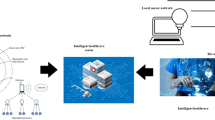Abstract
The wireless body area network (WBAN) is the developing technology which is used to monitor the patient’s activities. The main challenges in the WBAN are Qos, Energy consumption during the information transformation, Delay and security. Thus the paper contributes the proposed method which is used to manage the above challenges. Initially the node has been placed on the human body which is configured with the mobile devices for transmitting the information. The priority of the information is decided by the node or sensor placement by default head and heart sensors. Then the information is forwarded to the nearest remedy subscribed base station through cluster heads by using the virtual MIMO method. This method uses the opportunistic approach to minimize the decision making time of the priority and the transmission queueing process. The proposed system used to combine the two or more priority information with the help of the ACK time and PATH BEACON that utilizes the maximum bandwidth to forward the information without making the collision and delay.





Similar content being viewed by others
References
Sharma, S., Vyas, A. L., Thakker, B., Mulvaney, D., & Datta, S. (2011). “Wireless body area network for health monitoring”, In International conference on biomedical engineering and informatics (BMEI), vol. 4.
Patel, S., Park, H., Bonato, P., Chan, L., & Rodgers, M. (2012). A review of wearable sensors and systems with application in rehabilitation. Journal of Neuroengineering and Rehabilitation, 9, 21.
Kumar, Pardeep, & Lee, Hoon-Jae. (2012). Security issues in healthcare applications using wireless medical sensor networks: A survey. Journal of Sensors (Basel), 12(1), 55–91.
Jawarkar, U., Panchore, P., & Deshmukh, S. (2013). Overview of wireless sensor network and its applications. International Journal of Electronics Communication and Computer Engineering, 4(2), 29–32.
Verma, G., & Moinuddin, (2014). Body area network—A perspective. International Journal of Computer Science and Information Technologies, 5(5), 6802–6809.
Ullah, S., Khan, P., Ullah, N., Saleem, S., Higgins, H., & Kwak, K. S. (2010). A review of wireless body area networks for medical applications. http://arxiv.org/pdf/1001.0831.pdf.
Kim, K., Lee, I. S., Yoon, M., Kim, J., Lee, H., & Han, K. (2009). An efficient routing protocol based on position information in mobile wireless body area sensor networks. In International conference on networks and communications.
Wang, C., Wang, Q., & Shi, S. (2012). A distributed wireless body area network for medical supervision. In IEEE international instrumentation and measurement technology conference (I2MTC).
Argyriou, A., Breva, A. C., & Aoun, M. (2015). Optimizing data forwarding from body area networks in the presence of body shadowing with dual wireless technology nodes. IEEE Transactions on Mobile Computing, 14(3), 632–645.
Han, S.-H., & Park, S. K. (2011). Performance analysis of wireless body area network in indoor off-body communication. IEEE Transactions on Consumer Electronics, 57(2), 335–338.
He, D., Chan, S., Zhang, Y., & Yang, H. (2014). Lightweight and confidential data discovery and dissemination for wireless body area networks. IEEE Journal of Biomedical and Health Informatics, 18(2), 440–448.
Misra, S. (2015). Priority-based time-slot allocation in wireless body area networks during medical emergency situations: An evolutionary game-theoretic perspective. IEEE Journal of Biomedical and Health Informatics, 19(2), 541–548.
Ullah, N., Khan, P., & Kwak, K. S. (2011). A very low power MAC (VLPM) protocol for wireless body area networks. Journal of Sensors, 11(4), 3717–3737. https://doi.org/10.3390/s110403717.
ul Huque, M. T. I., Munasinghe, K. S., & Jamalipour, A. (2014). Body node coordinator placement algorithms for wireless body area networks. Internet of Things Journal in IEEE, 2(1), 94–102.
Chen, B., Varkey, J. P., Pompili, D., Li, J. K., & Marsic, I. (2010). Patient vital signs monitoring using wireless body area networks. http://www.ece.rutgers.edu/~pompili/paper/PID1139119.pdf. Accessed 24 Sep 2017.
Hauer, J. H., & Technische Universität Berlin, Germany. (2014). Leveraging human mobility for communication in body area networks. ACM Transactions on Sensor Networks (TOSN), 10(3), 39.
Sukor, M., Ariffin, S., Fisal, N., Yusof, S. S., & Abdallah, A. (2008). Performance study of wireless body area network in medical environment. In Asia international conference on modeling & simulation. AICMS 08.
Yoo, H.-J., & Bae, J. (2013). Low energy wireless body area network systems. In IEEE international wireless symposium (IWS).
Filipe, L., Fdez-Riverola, F., Costa, N., & Pereira, A. (2015). Wireless body area networks for healthcare applications: Protocol stack review. International Journal of Distributed Sensor Networks, 11, 23. 213705.
Siddiqui, M. A., Kamal, M. B., & Moinuddin, H. (2013). Towards the development of cross layer approachfor energy efficiency and mobile wireless body area networks. International Journal of Computer and Information Technology, 2(3) (ISSN: 2279-0764).
Milenković, A., Otto, C., & Jovanov, E. (2006). Wireless sensor networks for personal health monitoring: Issues and an implementation. Computer Communications in Elesvier, 29, 2521–2533.
Kim, J., Song, I., Jang, E., & Choi, S. (2012). A dynamic duty cycle MAC algorithm for wireless body area networks. International Journal of Bio-Science and Bio-Technology, 4(2), 84–92.
Latre, B., Braem, B., Moerman, I., Blondia, C., Reusens, E., Joseph, W., & Demeester, P. (2007). A low-delay protocol for multihop wireless body area networks. http://www.pats.ua.ac.be/content/publications/2007/bbraem07cicada.pdf?q=subcycle. Accessed 25 Sep 2017.
Rahim, A., Javaid, N., Aslam, M., Rahman, Z., Qasim, U., & Khan, Z. A. (2012).A comprehensive survey of MAC protocols for wireless body area networks. http://arxiv.org/pdf/1208.2351.pdf. Accessed 25 Sep 2017.
Author information
Authors and Affiliations
Corresponding author
Additional information
Publisher's Note
Springer Nature remains neutral with regard to jurisdictional claims in published maps and institutional affiliations.
Rights and permissions
About this article
Cite this article
Mohamed Shakeel, P., Baskar, S. & Selvakumar, S. Retrieving Multiple Patient Information by Using the Virtual MIMO and Path Beacon in Wireless Body Area Network. Wireless Pers Commun 108, 2359–2370 (2019). https://doi.org/10.1007/s11277-019-06525-5
Published:
Issue Date:
DOI: https://doi.org/10.1007/s11277-019-06525-5




